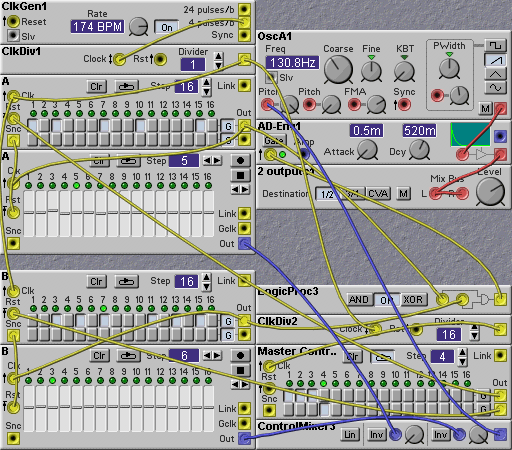
Case 1
I have a "how to" question. I'm working on a sequenced tune involving two parts, A and B. A is played 3 times, followed by B. A and B each consist of an event sequencer to trigger the notes, and a control sequencer to set the pitch.
The outputs from A and B event sequencers are or'ed and the output from the control sequencers are mixed using a control mixer. My preferred way of working is to have the event sequencers clock the control sequencers
This lets me play the melody into the control sequencer, and not have to worry about timing. The problem I'm having is that the control sequencer "sticks" on the last note at the end of each run. This is mixed in at the control mixer, causing the pitch to be "off".
What I really want to do is reset A's control sequencer when B's sequence begins, but the reset doesn't take effect until A's sequencer receives the next clock - I don't see how this could work.The solution I've come up with
is ugly. I've replicated notes in the control sequencer, and clocked it in synchony with the event sequencer.
Now, when the event sequencer "runs off the end", so does the control sequencer, and I don't get any unwanted signal out when the sequence isn't running. I don't like this solution - setting up the control sequencer is much more difficult.
Does anyone have a better solution for me ?
Case 2
I've received some much know-how from the knowledgable posts on this list; I thought I'd contribute a "how-to" of my own. I'm sure this won't be news to the more experienced NM'ers (I would imagine that many of the patches out in patch-land use this trick, unnoticed by me), but it may save some folks a bit of head-scratching.
The question to be addressed is: "how do you create a sequence that contains notes of different durations?" In order to have mixed durations (e.g., sixteenths, eighths, and quarter notes in the same sequence), you need to use the "gate" function in the event sequencer (the little G button to the right of the sequence buttons). Gate mode has the effect of merging adjacent "on" events into a single gate output. To produce a sixteenth note, turn on one trigger button. An eighth note consists of two adjacent trigger buttons; a quarter note of four adjacent buttons, etc. The problem with this, is how do you create notes without rests in between, for example, an eighth note immedately followed by a sixteenth (or even, two sixteenths in a row). Since gate mode merges all adjacent triggers, it would seem that the desired effect is not possible. The trick is to use the two rows of the event sequencer, switching back and forth between the rows whenever the sequence contains succesive notes that aren't separated by a rest, and then merging the two rows, using a logic "or".
One additional twist is required - the output gates still need to to have a "break" between them to produce separate notes, otherwise the gates for adjacent notes will still be mushed together. This is achieved by running the outputs from each event seq row separately through a very short delay for the positive edge of the gate. This allows the previous note's gate to return to 0, before the new note's gate is turned on (set to value 1). Note that this introduces a slight (in the example 1ms) delay in the sequenced output; any other parts of the patch that are to synchronize must have the same delay added to the clock signal. This is shown in the sample patch by a separate delay which is to be used to feed any other parts of the patch that are *not* going to use this trick.
The sample patch shows a mix of 1/6, 1/8, and 1/4 notes, some separated by rests, some not.
Case 3
The attached logic circuit is not doing what I expect (or want).
I expected this circuit to "get stuck" at the second position of the event sequencer. The idea is that when the second position is reached, the logic inverter signal goes "off", turning off the "and" gate, preventing future clock pulses from being received. Instead, another pulse is being received and the event seq is jumping from 2 to 3 almost instantaneously. Either I'm really thinking about this wrong, or there's some strange timing artifacts in how the NM is handling the computations. Anyone give me some insights?